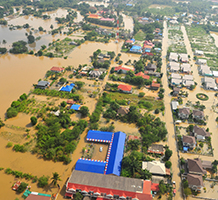
New research show blueprint for El Niño diversity
New research show blueprint for El Niño diversity
A pivotal new research study has isolated the key mechanisms that cause El Niño events to differ amongst each other.
Climate scientists have found that the complex and irregular occurrence of El Niño and La Niña events can be traced back to the co-existence of two coupled atmosphere-ocean oscillations, with different spatial characteristics and different frequencies.
The research, conducted by an international team including Alexander Todd from the University of Exeter, is published in leading scientific journal Nature on July 26 2018.
Alex, a Postgraduate student from Exeter’s Mathematics department said: “This study, arising from an international collaboration of over 40 scientists, advances our understanding of the spatial and temporal complexity of the El Niño-Southern Oscillation (ENSO).
“It also provides a physical basis for refining our projections of how ENSO and its associated global weather impacts are likely to change in a warming world.”
El Niño events are characterized by an unusual warming of the central to eastern equatorial Pacific, which can last up to one year. Many events subsequently transition to a La Niña (cold) state, with a typical duration of 1-2 years.
El Niño events, which tend to peak in boreal winter, typically lead to a drying of Southeastern Asia and the Western tropical Pacific whilst enhancing rainfall near the eastern Pacific shores, in countries such as Ecuador and Peru. El Niño’s remote “ripple effects” can not only be found in the atmosphere, but also in ocean currents, ecosystems, the occurrence of natural disasters, global markets and national economies.
Climate scientists have long recognized that not every El Niño is alike. Some are weak, others are strong. Some occur in the central Pacific, others in the east. These differences will determine which areas will be hit hardest by climatic extremes and which ones will be spared. Predicting El Niño events accurately requires a deeper understanding of its diversity or as some scientists call it — its “flavours”.
To reveal the origin of El Niño diversity, climate scientists from 11 countries met at the IBS Center for Climate Physics and Pusan National University, South Korea. Analysing large amounts of climate observations and computer model simulations, the team unraveled the mechanism behind El Niño’s capricious behaviour.
When the upper tropical Pacific Ocean stores more heat, El Niño events tend to peak in the Eastern Pacific and during boreal winter, whereas a cooler upper ocean system leads preferably to the development of Central Pacific El Niño events, which exhibit a weaker seasonal coupling.
By running El Niño computer model simulations for different temperature, wind and ocean current configurations the research team found that Eastern Pacific El Niño events are characterized by a return time of 3-7 years, whereas Central Pacific events tend to recur on average every 2-3 years (Figure 1).
The different character of these modes is determined by how strongly atmosphere and ocean interact with each other. The theoretical results presented in this study are consistent with observational datasets. In reality however, the co-existing Eastern and Central Pacific warm/cold swings are far from periodic.
The tropical Pacific climate systems requires constant excitation, either through random weather events or through atmospheric circulation changes induced by temperature changes in the Indian and Atlantic Oceans. These interactions are an important source for El Niño irregularity, and limit how far ahead Tropical Pacific climate anomalies can be predicted.
“Our study reveals that there is a hidden structure in the seemingly chaotic and unpredictable occurrence of El Niño events,” said Axel Timmermann, Director of the IBS Center for Climate Physics (ICCP) at Pusan National University and lead author of the study.
“Finally we can attribute the observed complexity of the most powerful natural climate engine to the co-existence of two oscillatory states of the underlying mathematical equations” said Fei-Fei Jin, professor for Atmospheric Sciences at the University of Hawai‘i, USA and co-author of this study.
“More comprehensive climate modeling studies have to be conducted now to test our new ideas in a more realistic setting and to determine whether we can expect shifts in El Nino characteristics in our warming world,” described Jeongseong Kug, one of the coordinating lead authors of the study and Professor at Pohang University of Science and Technology, South Korea.
Funding
This research was supported by the IBS Center for Climate Physics (South Korea), the National Research Foundation of Korea, the US National Science Foundation, the National Oceanic and Atmospheric Administration (USA), the China Meteorological Special Research Project, UK-China Research & Innovation Partnership Fund and the Newton Fund (UK) the National Environmental Science Program of Australia and Fondecyt (France).
Date: 26 July 2018